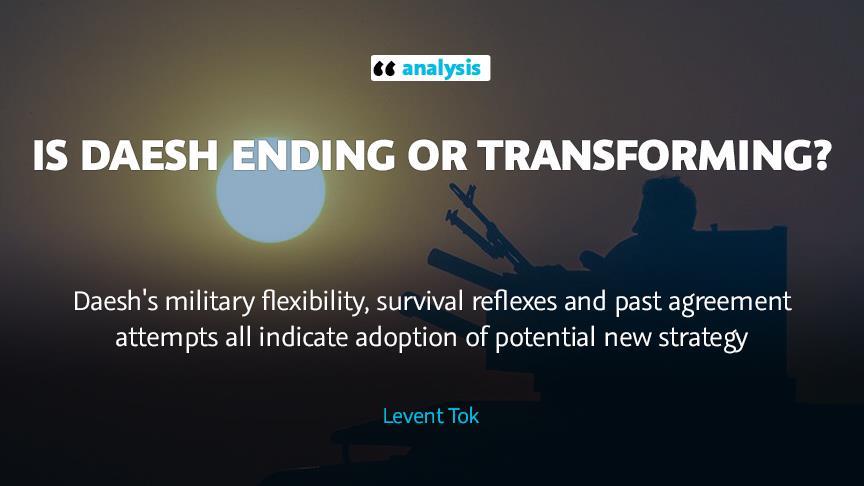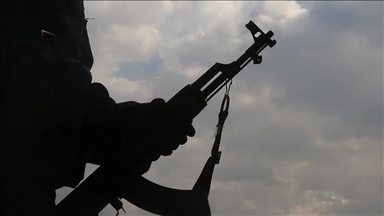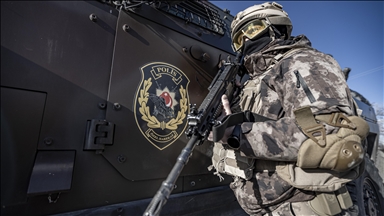
By Levent Tok
ISTANBUL
Causing great devastation to the Islamic world, the Daesh terror organization has lost a large part of the territory it once occupied. However, with thousands of militants remaining, the organization maintains its potential to turn to new strategies.
Daesh, which reached its peak by occupying two-thirds of Syria at the end of 2014, has rapidly been losing what it had since 2015.
Following the Ayn al-Arab [Kobani] siege, Daesh was defeated in clashes east of Aleppo and towards the north of Raqqah by the PKK/PYD which received U.S. and international coalition support.
Thus, it was trapped in a curve extending from northern Aleppo to southern Raqqah by the eve of 2016.
The terror group withdrew to the Deir ez-Zour region following a major defeat against Russia and the Bashar al-Assad regime in Aleppo and Homs. It was also besieged in the Raqqah city center by the U.S.-backed terror group PKK/PYD.
Daesh's struggle with its foreign fighter-based policy and human resource difficulties caused its attempts to reclaim the areas lost in military terms to be inconclusive.
Daesh spokesman Abu Muhammad al-Adnani, who was killed in 2016, in previous years made a statement about withdrawing to deserts as a result of the assaults against the group.
These losses were the first indicators of the organization's inability to fully embody their anticipated state claim.
As al-Adnani said, Daesh is rapidly withdrawing to the east of Syria. The organization that is stuck in the northeastern countryside of Deir ez-Zour near the Iraqi border is also holding Iraq's Anbar and the border to Anbar desert and the frontier from Hasakah to the south of Al-Hul in southern Deir ez-Zour.
In addition to this region, the organization is trying to protect its presence in the Syrian desert by retreating from Palmira in the past few months.
However, the Assad regime in the Euphrates Valley in Deir ez-Zour and Iran-backed terror groups along with Russian air support narrowing the Abu Kamal area near the Iraqi border and northern Mayadin area strengthen the likelihood Daesh will be surrounded in the desert.
Cells, actions, sudden operations
It is of course also possible that the organization chooses to retreat rather than be besieged. This is because we are talking about an organization which can develop sudden military operations via cells it gathers in regions it lost.
Similarly, from the recent example of Karyetein, we understand that the organization can use the areas lost in the front war as motivation for another action when transforming secret cells for a quick military operation.
Apart from all these large areas, two areas in Syria under the control of Daesh are noteworthy. These areas include settlements such as south of Damascus, Yarmouk, where Palestinian refugees have lived intensively, and west of Dera province near the border or Israeli-occupied Golan city, Ceylan, Advan and Tasil settlements.
Despite being under siege for a long time, the strategy of the militants in Yarmouk, who are far from the main frontline of the organization, is to attack opposition groups by making periodic agreements with the Assad regime which has strong air capability and logistics.
In Dera, the basic strategy of the organization, which has the Israeli army in the west, was to reach the road extending to Nera and Cisral-Ash via Dera. It is still an unanswered question how the organization acquired military logistics against the Syrian opposition.
It is a great possibility that the organization is attempting actions via its sleeper cells in the regime and opposition areas in Syria while its apparent control areas are reduced and other cells are left behind.
The organization's attacks in the northeastern countryside of Hama and Assad regime-held areas in eastern Hama until southern Aleppo against the opposition, all indicate Daesh's willingness to be open to all kinds of cooperation to survive.
Are Daesh members being destroyed?
Especially in the last period, the U.S. and European countries, during meetings of the Global Coalition Against Daesh, emphasized a strategy of killing the organization's members wherever they are.
The West and Russia see Syria particularly as an international pool of radical elements that they will dispose of in their hiding places.
In fact, the West and Russia for many years allowed these elements to leave their territories and flow into Syria and Iraq.
Now they want to destroy them without allowing them to return.
On the other hand, despite the news of "intense clashes" with "foreign Daesh militants", the failure to share arrest or death information does not escape one's attention.
This cannot explain what happened to these thousands of foreign fighters repeatedly raised by the U.S. and Russia.
Daesh's military resilience and survival reflexes through its past agreements and compromise initiatives point to the potential of crossing into a new strategy.
The Daesh-PKK/PYD evacuation deal in Raqqah, which was reported on by Anadolu Agency on Oct. 15 and was reported by BBC with several witnesses, must be assessed in this framework.
Most probable scenario
The most likely scenario is that foreigners from the Arabic-speaking Gulf and Maghreb have taken Syrian identities to take their place in cells behind the frontline or pass through to other countries in the guise of refugees. The situation is quite different for foreign fighters who do not speak Arabic.
The situation we encountered during the siege of Raqqah depicted the organization's foreign-fighters scenario. Daesh, which withdrew Arab-origin and local elements from Raqqah in a deal, left behind non-Arab elements except those in commander positions.
This preference supports the view that the goal of Daesh in the new era is possibly an Arab country.
Nonetheless, the United States and Russia, in particular, are allowing the evacuation of foreign fighters from Daesh regions, which they claim to have control of and have published data on along with their terrorist organization and the terrorist regime partners.
In this way, we will wait and see whether or not the organization will turn into a tolerated lever to be used in a new geography in the future.
It is possible to say likely scenarios include Arab countries located south of Syria and Iraq risk groups when considering the organization's separatist attitude within itself (Arabs / Arabic speakers, elite warriors / non-combatants) and the consensual evacuations that are tolerated by the U.S. and Russia.
It is still unknown how many Daesh members with an Arab identity move through the frontiers in Syria and Iraq, which still have not completed their internal and border security, and how many of them move through the frontiers of the Arab identity, and how many of them cross transnational boundaries under a refugee guise.
The analysis of the current parameters lists two Arab countries -- Jordan and Saudi Arabia -- at the forefront of the at-risk group.
Is Daesh defeated or changing?
Today in Syria, Daesh has lost a great deal of the route it created in southern Hasakah and Deir ez-Zour, Raqqah and east of Homs towards the east of Aleppo.
The organization's immediate conquest of the areas extending from Mosul and Ramadi to Aleppo, then losing it in within three years which caused ethnic and political transformation, left the region faced with many new problems.
However, the most underestimated issue and the one least talked about is the whereabouts of the thousands of foreign fighters from Daesh fronts.
The organization allegedly using large centers such as Raqqah, Deir ez-Zour, Mayadin and Abu Kamal as foreign fighter terminal, will either cause the organization to reassess many of its parameters which currently is stuck in the mainly desert side or will show us that Daesh has embraced a very different strategy at the front.
Defining loss of land as a defeat for the organization which has fighters from various origins and languages is an unacceptable situation for the organization's sociology.
On the other side, it should be taken into consideration that the continuity of language and discourse is preserved in broadcasting media addressing the organization itself and its sympathizers.
Through the apparent observations and inferences on Daesh, a new type of organization combined with an Al Qaeda like structure and Iraqi Baath intelligence gathering, is probably have gone through a change in military strategy in order to maintain its presence, even if defeated in front of the military war.
* Opinions expressed in this article are the author’s own and do not necessarily reflect the editorial policy of Anadolu Agency.
Anadolu Agency website contains only a portion of the news stories offered to subscribers in the AA News Broadcasting System (HAS), and in summarized form. Please contact us for subscription options.




